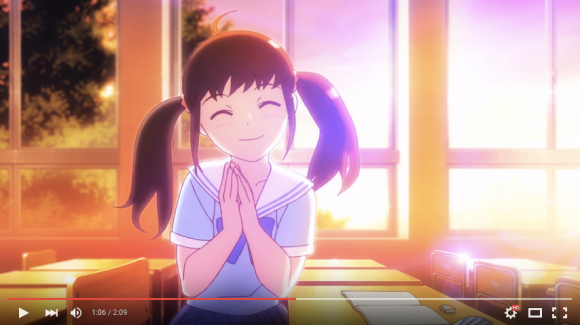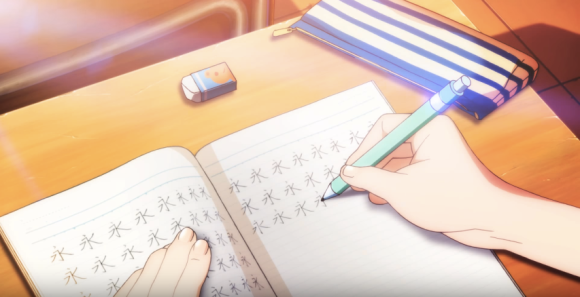
Kanji characters are one of the most fascinating, but also the most troublesome, aspects of the Japanese language—and that goes not just for foreign learners but also for Japanese natives. The Kanji Kentei is a standardized test that you can take to prove your kanji knowledge, but after being drilled on the kanji throughout their school lives Japanese people might not be taken by the idea of sitting for even more exams on the subject.
That’s why the Kanji Kentei administrators, in an effort to encourage people to give up their free time to study kanji and take their exams, has fallen back on the failsafe go-to of Japanese advertising: cute, nostalgic anime.
During their school years Japanese children are taught the 2,136 jouyou, or “everyday use”, kanji, which is the amount you supposedly need to be literate. So long as you have these down you should have no trouble reading most text that will crop up in everyday life and in the majority of newspapers.
As anyone who’s grown up with a phonographic language rather than a logographic one will tell you, however, learning kanji can be difficult. Each character has a specific combination of strokes, as well as multiple possible ways to read it. It’s even difficult for Japanese people, which always makes me feel better but at the same time frustrates me—how the heck am I supposed to learn all these things when even people brought up using the language can’t?!?
Clearly aware that the chance to sit a kanji exam is hardly something that the average person would leap at, the Japan Kanji Aptitude Testing Public Interest Foundation, which is responsible for administering the Kanji Kentei (kanji aptitude test), has released a super-short anime called Kanojo ga Kanji wo Sukina Riyu, or The Reason She Likes Kanji. It’s split into two bite-sized parts of less than three minutes each, and draws on people’s rose-tinted memories of high school and their love of cute anime girls to get them interested in kanji and in taking their exam. Because, let’s be honest, exams are probably one of the toughest products out there to sell.
Check out the videos here. Keep scrolling for a quick summary of each and for more about studying kanji and the Kanji Kentei itself.
Part 1
Haruka Hirai is alone in the classroom after school writing her favourite kanji, 永 (ei) which is part of the compound 永遠 (eien, or eternity). Yusuke Sagara happens to come back to the classroom and sees her, and in that moment he falls in love. Yusuke asks her if she likes kanji and she replies that she loves it. Then, being a boy, he pretends he hasn’t heard her properly and keeps asking her to repeat it, which sounds like she’s saying she loves him given the lack of an object in Japanese sentence structure. She tells him why she finds this character beautiful and then asks Yusuke if he likes kanji, too, and of course he replies that he does, because how else are you supposed to respond to a pretty girl? And so the start of a beautiful relationship is born, all thanks to the power of kanji!
Part 2
Haruka and Yusuke are on a not-date at the park when Yusuke starts speaking in yojijukugo, four-kanji idiomatic expressions that he thinks will totally make him sound cool and intelligent if he busts them out in a conversation with a girl. Later, Yusuke notes that Haruka seems to glow whenever she’s talking about kanji and she says that kanji widens her world. After that the two of them then head towards the boating lake. Yusuke has heard a legend that couples who go for a boat ride on it break up, but Haruka cheerfully tells him they’ll be fine since they’re not a dating. But after spending a romantic time on the lake together, at the end she asks him to teach her yojijukugo and says that it’s a good job they rode the boat now because they won’t be able to after they’re dating…! Looks like kanji has worked its magic yet again.
Unlike the Japanese Language Proficiency Test, which is for learners of Japanese as a second language, the Japan Kanji Aptitude Test (Kanji Kentei) is designed for native speakers (although of course foreign learners of the language can take it too!). There are 10 levels, with 1 being the hardest. The first seven are relatively easy, corresponding to elementary and middle school-levels. Level 3 steps it up as the level high school students aim for, and 2 is most often taken by adult and university students who have an interest in or specific need for kanji.
Then there’s Level 1, which tests examinees on 6,355 kanji, which is apparently so difficult that less than 2,000 people take the exam each time it is held, and less than 15 percent of those who take it actually pass. If you manage to pass Level 1 you basically have the right to call yourself a kanji master.
But hey, with the promise of all that love and romance, who wouldn’t want to pick up a pencil and start practising those kanji radicals?? Good luck, everyone!
Video/screenshots: YouTube/Japan Kanji Aptitude Testing Public Interest Foundation
Studying Japanese? Don’t miss:
Six (and a half) essential resources for learning Japanese
[ Read in Japanese ]



 Foreigners misreading Japanese kanji of “two men one woman” is too pure for Japanese Internet
Foreigners misreading Japanese kanji of “two men one woman” is too pure for Japanese Internet Eye-opening tutorial reveals daily makeup routine of a Japanese kuro-gyaru【Video】
Eye-opening tutorial reveals daily makeup routine of a Japanese kuro-gyaru【Video】 Renowned Japanese calligraphy teacher ranks the top 10 kanji that foreigners like
Renowned Japanese calligraphy teacher ranks the top 10 kanji that foreigners like Japan has a cat aptitude test to show off how much you know about our feline friends
Japan has a cat aptitude test to show off how much you know about our feline friends “A dead bug” and other amusing, adorable, snarky, and downright ridiculous test responses
“A dead bug” and other amusing, adorable, snarky, and downright ridiculous test responses How to order snacks on a Shinkansen bullet train in Japan
How to order snacks on a Shinkansen bullet train in Japan Demon Slayer: Kimetsu no Yaiba gets new roller coaster attractions and food at Universal Studios Japan
Demon Slayer: Kimetsu no Yaiba gets new roller coaster attractions and food at Universal Studios Japan New samurai glasses are Japan’s latest weird must-have souvenir
New samurai glasses are Japan’s latest weird must-have souvenir Burger King Japan suddenly adds Dr. Pepper and Dr. Pepper floats to its menu nationwide
Burger King Japan suddenly adds Dr. Pepper and Dr. Pepper floats to its menu nationwide Nintendo history you can feel – Super NES, N64, and GameCube controllers become capsule toys
Nintendo history you can feel – Super NES, N64, and GameCube controllers become capsule toys High-fashion Totoro cuddle purse is like an elegant stroll in the forest【Photos】
High-fashion Totoro cuddle purse is like an elegant stroll in the forest【Photos】 Japan’s new difficult-to-drink-from beer glass protects your liver, but it’s a brutal experience
Japan’s new difficult-to-drink-from beer glass protects your liver, but it’s a brutal experience Kyoto Tower mascot termination reveals dark side behind cute Japanese characters
Kyoto Tower mascot termination reveals dark side behind cute Japanese characters New Pokémon ice cream, dessert drinks, and cool merch coming to Baskin-Robbins Japan【Pics】
New Pokémon ice cream, dessert drinks, and cool merch coming to Baskin-Robbins Japan【Pics】 To combat declining birth rate, Japan to begin offering “Breeding Visas” to foreigners
To combat declining birth rate, Japan to begin offering “Breeding Visas” to foreigners Hello, cosmetics! Clinique teams up with Hello Kitty this summer for first-time collaboration
Hello, cosmetics! Clinique teams up with Hello Kitty this summer for first-time collaboration “The most Delicious Cup Noodle in history” – Japan’s French Cup Noodle wins our heart【Taste test】
“The most Delicious Cup Noodle in history” – Japan’s French Cup Noodle wins our heart【Taste test】 Starbucks releases a cute Frappuccino and Unicorn Cake…but not in Japan
Starbucks releases a cute Frappuccino and Unicorn Cake…but not in Japan McDonald’s Japan’s Soft Twist Tower: A phantom ice cream only sold at select branches
McDonald’s Japan’s Soft Twist Tower: A phantom ice cream only sold at select branches Yabai Ramen: What makes this Japanese ramen so dangerous?
Yabai Ramen: What makes this Japanese ramen so dangerous? Finally! Nintendo Japan expands Switch 8-bit controller sales to everybody, Online member or not
Finally! Nintendo Japan expands Switch 8-bit controller sales to everybody, Online member or not Japanese government wants to build luxury resorts in all national parks for foreign tourists
Japanese government wants to build luxury resorts in all national parks for foreign tourists 10 things you should buy at 7-Eleven in Japan
10 things you should buy at 7-Eleven in Japan Studio Ghibli releases anime heroine cosplay dresses that are super comfy to wear
Studio Ghibli releases anime heroine cosplay dresses that are super comfy to wear Woman charged for driving suitcase without a license in Osaka
Woman charged for driving suitcase without a license in Osaka Studio Ghibli unveils My Neighbour Totoro miniature house model
Studio Ghibli unveils My Neighbour Totoro miniature house model Kyoto experiencing problems with foreign tourists not paying for bus fares, but not on purpose
Kyoto experiencing problems with foreign tourists not paying for bus fares, but not on purpose Fighting mild hunger with a Japanese soda that turns into jelly in the stomach【Taste test】
Fighting mild hunger with a Japanese soda that turns into jelly in the stomach【Taste test】 Studio Ghibli’s Howl’s Moving Castle tapestry unveiled in Japan for first time
Studio Ghibli’s Howl’s Moving Castle tapestry unveiled in Japan for first time McDonald’s new Happy Meals offer up cute and practical Sanrio lifestyle goods
McDonald’s new Happy Meals offer up cute and practical Sanrio lifestyle goods Sales of Japan’s most convenient train ticket/shopping payment cards suspended indefinitely
Sales of Japan’s most convenient train ticket/shopping payment cards suspended indefinitely Sold-out Studio Ghibli desktop humidifiers are back so Totoro can help you through the dry season
Sold-out Studio Ghibli desktop humidifiers are back so Totoro can help you through the dry season Japanese government to make first change to romanization spelling rules since the 1950s
Japanese government to make first change to romanization spelling rules since the 1950s Foreigner’s request for help in Tokyo makes us sad for the state of society
Foreigner’s request for help in Tokyo makes us sad for the state of society Ghibli founders Toshio Suzuki and Hayao Miyazaki contribute to Japanese whisky Totoro label design
Ghibli founders Toshio Suzuki and Hayao Miyazaki contribute to Japanese whisky Totoro label design Doraemon found buried at sea as scene from 1993 anime becomes real life【Photos】
Doraemon found buried at sea as scene from 1993 anime becomes real life【Photos】 Tokyo’s most famous Starbucks is closed
Tokyo’s most famous Starbucks is closed Princesses, fruits, and blacksmiths: Study reveals the 30 most unusual family names in Japan
Princesses, fruits, and blacksmiths: Study reveals the 30 most unusual family names in Japan Japan announces Kanji of the Year for 2019, and it was really the only logical choice
Japan announces Kanji of the Year for 2019, and it was really the only logical choice “Gold” named 2016 Kanji of the Year
“Gold” named 2016 Kanji of the Year Poop Kanji-Drill toilet paper is the best way to accomplish your Japanese studying doo-ties
Poop Kanji-Drill toilet paper is the best way to accomplish your Japanese studying doo-ties Tired of wasting paper practicing your kanji? Try these reusable water-activated practice sheets
Tired of wasting paper practicing your kanji? Try these reusable water-activated practice sheets Twitter users say Japanese Prime Minister’s name is hiding in the kanji for Japan’s new era name
Twitter users say Japanese Prime Minister’s name is hiding in the kanji for Japan’s new era name Kanji fail — Japanese parents shocked to learn their baby girl’s name has inappropriate meaning
Kanji fail — Japanese parents shocked to learn their baby girl’s name has inappropriate meaning Japanese study tip: Imagine kanji characters as fighting game characters, like in this cool video
Japanese study tip: Imagine kanji characters as fighting game characters, like in this cool video U.S. college student learns the hard way to get your Japanese kanji tattoo checked by an expert
U.S. college student learns the hard way to get your Japanese kanji tattoo checked by an expert “Disaster”: 2018 Kanji of the Year unveiled by Buddhist monk at Kiyomizudera temple in Kyoto
“Disaster”: 2018 Kanji of the Year unveiled by Buddhist monk at Kiyomizudera temple in Kyoto What’s funnier and more likely to make you study than poo? How about male pattern baldness?
What’s funnier and more likely to make you study than poo? How about male pattern baldness? Four new era names the Japanese government rejected before deciding on Reiwa
Four new era names the Japanese government rejected before deciding on Reiwa Japanese toilet paper collection opens our minds as we open our butts
Japanese toilet paper collection opens our minds as we open our butts Transforming kanji watches not so great for telling time, perfect for being awesome
Transforming kanji watches not so great for telling time, perfect for being awesome Japan’s kanji character of the year for 2017 is “north”
Japan’s kanji character of the year for 2017 is “north” Anime Romance Video Promotes Super Glue on ‘Kiss Day’
Anime Romance Video Promotes Super Glue on ‘Kiss Day’ Learn Japanese kanji with captivating stop-motion videos created by Tokyo animator
Learn Japanese kanji with captivating stop-motion videos created by Tokyo animator
Leave a Reply